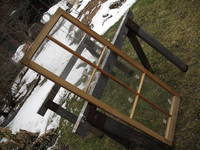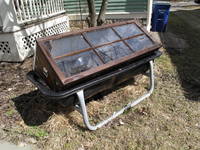This cold frame was 20 years in the making - and perfect for a chilly Michigan spring

Jim Leach | Contributor
For quite a while, however, I've wanted a real cold frame with a sturdy wooden box and a true glass window with glazing. For how long?
I scavenged the window two decades ago. A couple 4-by-4s came from a student loft — a student who must have graduated in the mid-90s. A few nicely sized pieces of one-inch plywood became available last fall when we demolished some shelves. I have a box of hinges and handles that came from some hardware close-out along the line.
But the parts would never have come together if not for that early season gardener’s itch. The soil’s too wet to till but the weather is too glorious to stay cooped up. Building a cold frame is the next best thing to gardening.
The key dimensions all came from the window, so I’m not including measurements in these instructions. Construction should be easy enough to figure out from the pictures, and more step-by-step pictures can be found here.
Yes, yes, yes, of course, there's a "correct" angle for a cold frame so that it catches the mathematically optimal amount of sunlight. But then, there is also the best angle possible for this particular window frame and this particular board. I figured that the spring sun is still relatively low in the sky and adjusted my angles accordingly.
I'm wary of pressure-treated lumber in yard project, but I didn’t want the cold frame to rot out quickly. My compromise was a coat of stain or primer for any raw wood. Stain and primer both sink in better than a simple coat of paint.
I haven't heard anyone suggest this idea, but I thought if I painted the inside of the cold frame white, the light might bounce around a bit.
Many jokes have been made about how every problem resembles a nail when the only tool at your disposal is a hammer. That folksy wisdom aside, I surely have found a lot of problems that are resolved by four-inch lag screws. I keep a box on my tool shelf, and they were the fastener of choice on this project.
I must confess that I purchased 16 two-inch washers from the kind folks at Stadium Hardware. The total for the washers was $3.20. Everything else was scavanged, which brings the total cost of the project to $3.20.

Janice Leach | Contributor
Janice and Jim Leach garden a backyard plot in downtown Ann Arbor and tend the website 20 Minute Garden.

